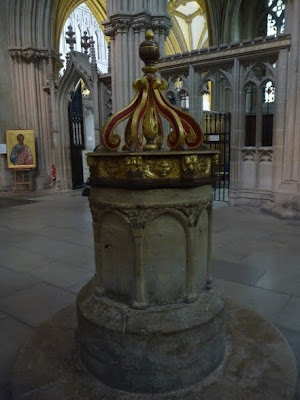 |
Back the other way on the Ridgeway is Uffington Castle, the remains of one of the more prominent Iron Age hill forts in the region. |
 |
Ditch and bank |
 |
Signpost |
 |
Contemporary megaliths |
...recounts the retirement travels of Mark and Vicki Sherouse since 2008...in Asia and the Pacific, New Zealand, Europe, South America, and Africa, as well as the US and Canada. Our website, with much practical information, is: https://sites.google.com/site/theroadgoeseveron/.Contact us at mark.sherouse@gmail.com or vsherouse@gmail.com.
 |
Vicki |
 |
Me |
 |
Parts of the Ridgeway admit automobile traffic; even Tom was impressed... |
 |
I rest my case |
 |
Me by one of the smaller stones |
 |
Part of the array |
 |
Vicki by one of the medium-sized ones |
 |
One of the really huge ones |
 |
Still more |
 |
Up closer; sheep's eye view |
 |
No climbing, humans |
 |
Cup marks on the big stones |
 |
Part of the passage-way |
 |
Exterior view...just a long mound |
 |
Silbury Hill in the distance |
 |
Inside, from the original Saxon cathedral, the
baptismal font, made to celebrate 1000AD
|
 |
Fashion statement: on the side of the font, hundreds of years
later, someone has tried to re-shape the Romanesque arch
into a Gothic arch
|
 |
On one of the pillars, a very famous depiction
of a medieval toothache
|
 |
The buttressing seen from the nave; there are
three of the buttressing figures, the nave, and
both transepts, humongous
|
 |
The oldest still functioning cope chest, 1120
|
 |
A figure in the chapter house, sticking his
tongue out at the bishop
|
 |
Wells Cathedral clock--the oldest complete still-functioning
clock in the world, 1390 (Salisbury's is a bit older, but has no
face and does not do minutes...a clock precursor) |
 |
It still powers a variety of cathedral bells and
whistles
|
 |
Wells Cathedral is best known for its west
facade, marvelous and pretty much intact
sculpture. Oh yes, there's a bishop's
palace, the old city itself, smallest cathedral
city in England, is beautiful
|
 |
Interior, looking up at the crossing ceiling, 10 or more
stories above, and organ; I'll have more on the crossing
in the next post...another extraordinary 14th century
cathedral repair job
|
 |
Apse ceiling
|
 |
West window
|
 |
Choir, beautiful textile work, wonderful
misericords
|